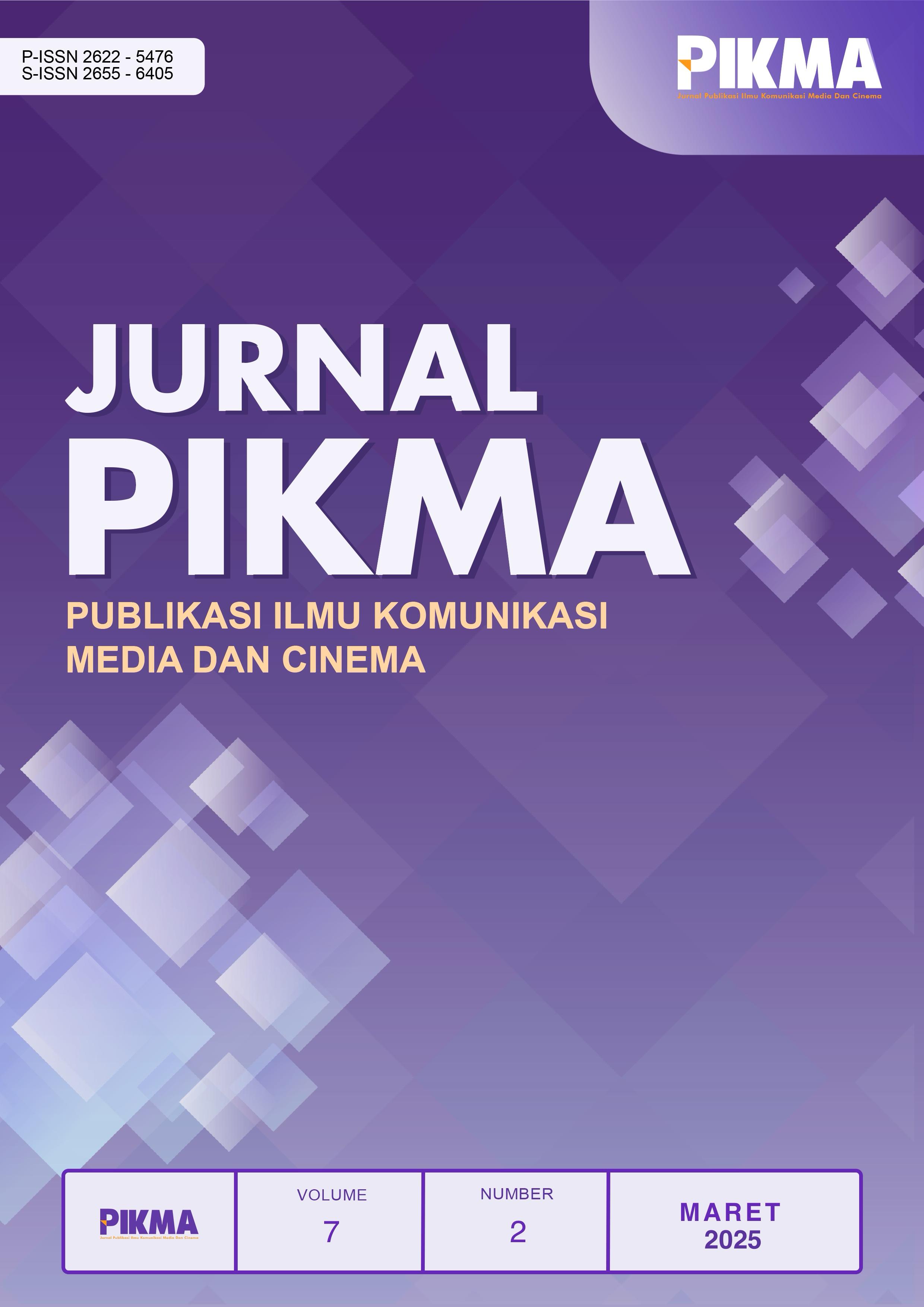Persuasive Strategies in WHO's Dengue Awareness Posters: ELM-Based Content Design in Vietnam
DOI:
https://doi.org/10.24076/pikma.v7i2.2014Keywords:
ELM, poster analysis, health communication, persuasiveness in mediaAbstract
Public health communication is essential for raising awareness and influencing behavior. In Vietnam, dengue fever remains a major health concern, with WHO-designed posters promoting prevention and management. However, their persuasive effectiveness remains underexplored. This study applies the Elaboration Likelihood Model (ELM) to analyze these posters and propose improvements.
A qualitative content analysis of eight WHO dengue prevention posters published on Facebook (September 2022–2023) examined central cues (message clarity, logical argumentation, action-oriented guidance) and peripheral cues (visual appeal, emotional engagement, source credibility). Findings show a strong reliance on central cues, while peripheral elements—such as striking visuals and digital engagement—are underutilized, limiting persuasive impact.
To enhance effectiveness, the study recommends improving visual appeal, incorporating emotional triggers, and optimizing digital engagement. These insights contribute to applying ELM in health communication and improving public health messaging in Vietnam.
References
Andreoli, V., & Worchel, S. (1978). Effects of media, communicator, and message position on attitude change. Public Opinion Quarterly, 42(1), 59–70. https://doi.org/10.1086/268429
Baran, S. J., & Davis, D. R. (2021). Mass Communication Theory: Foundations, Ferment and Future (8th ed.). Oxford University Press.
Bhattacherjee, A., and Sanford. C.(2006). Influence processes for information technology acceptance: An elaboration likelihood model. MIS Quarterly, 30 (4), 805–825.
Briñol, P., & Petty, R. E. (2009). Persuasion: Insights from the self-validation hypothesis. Advances in Experimental Social Psychology, 41, 69–118. https://doi.org/10.1016/S0065-2601(08)00402-4
Cacioppo, J. T., Petty, R. E., & Stoltenberg. C. D. (1985). Process of social influence: The elaboration likelihood model of persuasion. Advances in Cognitive- Behavioral Research and Therapy, 4, 215–273.
Chaiken, S., & Maheswaran, D. (1994). Heuristic processing can bias systematicprocessing: Effects of source credibility, argument ambiguity, and task importance on attitude judgment. Journal of Personality and Social Psychology, 66(3), 460. https://doi.org/10.1037/0022-3514.66.3.460
Chen, S., & Chaiken, S. (1999). The heuristic-systematic model in its broader context. In S. Chaiken & Y. Trope (Eds), Dual process theories in social psychology (pp.73-96). Guilford Press.
Cheung, M. Y., C. Luo, C. L. Sia, and H. Chen. 2009. Credibility of electronic word-of-mouth: Informational and normative determinants of on-line consumer recommendations. International Journal of Electronic Commerce 13 (4), 9–38.
Dung, L. V., & Nghia, N. T. (2023). Research of knowledge, attitude, practice on dengue hemorrhagic fever prevention on people in Vung Liem district, Vinh Long province in 2022-2023. Can Tho University of Medicine and Pharmacy, 66, 157-163.
Elizabeth, H. J., Millward, G., & Mold, A. (2019). ‘Injections-While-You-Dance’: Press Advertisement and Poster Promotion of the Polio Vaccine to British Publics, 1956–1962. Cultural and Social History, 16(3), 315–336. https://doi.org/10.1080/14780038.2019.1586061
Flynn, B. S., Worden, J. K., Bunn, J. Y., Connolly, S. W., & Dorwaldt, A. L. (2011). Evaluation of smoking prevention television messages based on the elaboration likelihood model. Health Education Research, 26(6), 976–987. doi:10.1093/her/cyr082
Griffin, D. (2015). Posters for public health: WPA posters and national dialogues about health care in the United States. Communication Design, 3(2), 124–141. https://doi.org/10.1080/20557132.2016.1201913
Hamilton, K., & Harper, J. C. (2024). Young adult’s views on using a poster to learn about fertility: redesigning the fertility education poster. Human Fertility, 27(1). https://doi.org/10.1080/14647273.2024.2345675
Hass, R. G. (1981). Effects of source characteristics on cognitive responses in persuasion. In R. E. Petty, T. M. Ostrom, & T. C. Brock (Eds.), Cognitive responses in persuasion (pp.141–172). Lawrence Erlbaum Associates. https://ci.nii.ac.jp/naid/10025008080/
Hesse, B. W., Nelson, D. E., Kreps, G. L., Croyle, R. T., Arora, N. K., Rimer, B. K., & Viswanath, K. (2005). Trust and sources of health information: the impact of the Internet and its implications for health care providers: findings from the first Health Information National Trends Survey. Archives of internal medicine, 165(22), 2618–2624. https://doi.org/10.1001/archinte.165.22.2618
Ishikawa, H., & Kiuchi, T. (2010). Health literacy and health communication. BioPsychoSocial medicine, 4, 18. https://doi.org/10.1186/1751-0759-4-18
Khaleghimoghaddam, N. (2023). Understanding the interplay of light, color, and interior design in healthcare spaces. Journal of Design for Resilience in Architecture and Planning, 4(2), 219–231.
https://doi.org/10.47818/DRArch.2023.v4i2094
King, A. J. (2015). Visual messaging and risk communication. In H. Cho,T. Reimer, & K. A. McComas (Eds.), The SAGE handbook of risk communication (pp. 193–205). Sage.
King, A. J., & Lazard, A. J. (2020). Advancing Visual Health Communication Research to Improve Infodemic Response. Health Communication, 35(14), 1723–1728. https://doi.org/10.1080/10410236.2020.1838094
Lam, C., Huang, Z., & Shen, L. (2022). Infographics and the Elaboration Likelihood Model (ELM): Differences between Visual and Textual Health Messages. Journal of Health Communication, 27(10), 737–745. https://doi.org/10.1080/10810730.2022.2157909
Luong, D.C. (2024, July 22). Mùa s?t xu?t huy?t th??ng x?y ra vào mùa nào? Tháng m?y cao ?i?m? (When does dengue fever usually occur? Which month is peak?). VNVC news. Retrieved at : https://vnvc.vn/mua-sot-xuat-huyet/#:~:text=Theo%20ghi%20nh%E1%BA%ADn%2C%20t%E1%BB%AB%20th%C3%A1ng,khu%20v%E1%BB%B1c%20s%E1%BB%91ng%20s%E1%BA%A1ch%20s%E1%BA%BD (19, Jan , 2025).
Ministry of Health (2024). C? n??c ?ã ghi nh?n 114.900 ca m?c s?t xu?t huy?t, v?n có b?nh nhân vào vi?n trong tình tr?ng n?ng (The whole country has recorded 114,900 cases of dengue fever, with patients still hospitalized in serious condition). Retrieved at : https://moh.gov.vn/hoat-dong-cua-dia-phuong/-/asset_publisher/gHbla8vOQDuS/content/ca-nuoc-a-ghi-nhan-114-900-ca-mac-sot-xuat-huyet-van-co-benh-nhan-vao-vien-trong-tinh-trang-nang?inheritRedirect=false (19, Jan, 2025).
Napoli, P.M. (2001). Consumer Use of Medical Information from Electronic and Paper Media: A Literature Review.
Petty, R. E., & Cacioppo, J. T (1984). Source factors and the elaboration likelihood model of persuasion. Advances in Consumer Research 11, 668–672.
Petty, R.E., & Cacioppo, J.T. (1986). The elaboration likelihood model of persuasion. In L.Berkowitz (Ed.), Advances in experiemental social psychology, vol.19 (pp. 123-205). New York: Academic Press.
Petty, R. E., Briñol, P., Teeny, J., & Horcajo, J. (2017). The elaboration likelihood model: Changing attitudes toward exercising and beyond. In B. Jackson, J. A. Dimmock, & J. Compton (Eds.), Persuasion and communication in sport, exercise, and physical activity (pp. 22–37). London: Routledge. doi:10.4324/9781315624365
Qin M, Zhu W, You C, Li S and Qiu S (2022). Patient’s behavior of selection physician in online health communities: Based on an Elaboration likelihood model. Frontiers in Public Health, 10, 986933. https://doi.org/10.3389/fpubh.2022.986933
Smith, S. M., & Shaffer, D. R. (1995). Speed of speech and persuasion: Evidence for multiple effects. Personality and Social Psychology Bulletin, 21(10), 1051–1060.https://doi.org/10.1177/01461672952110006
Susmann, M. W., Xu, M., Clark, J. K., Wallace, L. E., Blankenship, K. L., Philipp-Muller, A. Z., … Petty, R. E. (2021). Persuasion amidst a pandemic: Insights from the Elaboration Likelihood Model. European Review of Social Psychology, 33(2), 323–359. https://doi.org/10.1080/10463283.2021.1964744
Teng, S., Khong, K. W., & Goh, W. W. (2014). Conceptualizing Persuasive Messages Using ELM in Social Media. Journal of Internet Commerce, 13(1), 65–87. https://doi.org/10.1080/15332861.2014.910729
Thomas, M., Wirtz, B.W., & Weyerer, J.C. (2019). Determinants of Online Review Credibility and Its Impact on Consumers' Purchase Intention. Journal of Electronic Commerce Research, 20, 1.
Tian, Y., Zhang, H., Jiang, Y., & Yang, Y. (2021). Understanding trust and perceived risk in sharing accommodation: an extended elaboration likelihood model and moderated by risk attitude. Journal of Hospitality Marketing & Management, 31(3), 348–368. https://doi.org/10.1080/19368623.2022.1986190
Verma, A. (2022). Optimizing Health Communication Noticeability with Visual Design and Humor: An Applied Approach for COVID-19 Public Messaging. Journal of Health Communication, 27(4), 262–269. https://doi.org/10.1080/10810730.2022.2089782
Wagner, B.C., & Petty, R.E. (2024). The Elaboration Likelihood Model of Persuasion: Thoughtful and Non?Thoughtful Social Influence. In D. Chadee (2nd Ed.), Theories in Social Psychology (pp.120-142) John Wiley & Sons Ltd.
Withers, G. F., Twigg, K., Wertheim, E. H., & Paxton, S. J. (2002). A controlled evaluation of an eating disorders primary prevention videotape using the elaboration likelihood model of persuasion. Journal of Psychosomatic Research, 53(5), 1021–1027. doi:10.1016/S0022-3999(02)00493-2
Downloads
Published
Issue
Section
License
Copyright (c) 2025 Jurnal PIKMA : Publikasi Ilmu Komunikasi Media Dan Cinema

This work is licensed under a Creative Commons Attribution-NonCommercial 4.0 International License.








